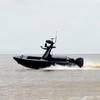SHORTSEA CRANE OPERATIONS: Lifting a Port to Prosperity
A Liebherr LHM 420 Crane is at the heart of a rapidly expanding shortsea shipping success story. Reliability is the key for a port that’s turned the corner, with nowhere to go but ‘up.’
Way back in January of 1996, I moved to Richmond, Virginia from Houston, Texas. Still very much in the maritime business as a cargo surveyor and ship expeditor, the Port of Richmond intrigued me, every time I drove past it on I-95. Eventually, I got a tour of the struggling port, courtesy of then port director and retired USCG Captain Marty Moynihan. Moynihan, an energetic executive, was keen to expand the port’s horizons.
Back then, as much as half of the port’s meager business was tobacco shipping to and from Philip Morris, just across the street. Still, Moynihan persisted, and the port – later helped by Sean Connaughton, Virginia’s Secretary of Transportation from 2010 until 2014, and prior to that, the U.S. Maritime Administrator from 2006 until early 2009 – slowly came to life. Connaughton, then a huge supporter of shortsea shipping, put the muscle of those state and federal government positions to work, advancing the role of inland waterways in the nation’s intermodal equation.
Humble Beginnings, Great Potential
In September 2006, when Connaughton assumed the helm of the Maritime Administration, he focused on developing the foundation for a more efficient marine highway system. And, Richmond was, for this Commonwealth resident, the perfect place to start. It was slow going and the initial efforts to get a container-on-barge service up and running from the Hampton Roads area was very much a ‘chicken and egg’ proposition.
Shippers were unwilling to commit to regular freight volumes and tug and barge operators on the route also struggled to make a living. Indeed, the year 2008 saw less than 150 containers moving through the port via barge. What a difference a decade can make. The Richmond Marine Terminal, as it has been rebranded, reported 29,685 box movements in 2018 alone. The terminal’s original 80-foot barge has since been replaced by another barge, the 309-foot LOA Richmond Express. A second, similar-sized barge has since joined to rotation. As many as 40 containers can fit onto each barge.
The Virginia Port Authority, eager expand opportunities for its impressive, modern Hampton Roads port complex, also knows that their intermodal operations will only be as good as the modes that follow them in the intermodal supply chain. The days of relying on trucks on the congested I-64 corridor are slowly coming to an end. One way to beat that bottleneck is to ship via rail to the Front Royal inland port, located near the confluence of Interstate highways 81 and 66. The other alternative, the Richmond Marine Terminal, reached via barge, is also becoming an increasingly popular choice for shippers.
With three barge shipments per week now the standard, and the possibility of a fourth coming very soon, reliability for this relatively obscure inland port will be everything. Virginia Ports envision the service expanding to 60,000 containers per year, or twice its current volume, something that would remove as many as 120,000 trucks off Interstate 64, along with the NOx, SOx and particulate matter associated with those engines.
None of that can happen without the crane equipment needed to quickly and safely load and unload these critical cargoes. Hence, when the Port of Virginia doubled down on their commitment to the shortsea, container-on-barge concept and extended what had been a series of five year leases to a 40-year pact, they bought – with the help of Marad – a dedicated harbor crane – the Leibherr LHM 420 version.
Meet the Leibherr LHM 420
The LHM 420 is 124 metric ton class crane and was delivered in 2016. The port purchased it mainly for container handling, the modern unit is versatile enough to efficiently handle project cargo, breakbulk and with the motor grab, bulk handling with 90 metric ton handling curve is possible, as well.
In practice, the Liebherr LHM is a modular crane; hence Liebherr adopts it for each individual customer and its intended operations. In this case, it is comprised of a 2-rope machine with a rotator and spreader to handle containers, project cargo and breakbulk, as well. According to Liebherr, a 4-rope crane would also have been feasible, but typically bulk operations that predominantly handle bulk would have preferred such a configuration, so hence the 2-rope with the motor grab load chart was chosen in this instance.
The standard pad sizes were already bringing down the corner loads of the crane sufficient enough for the pier loading capacity. Hence, the adapting of the crane is quite possible, and the port can easily relocate this crane to another location in the facility.
Special features of the crane include Liebherr’s Advanced Container Control handling which allows the operator to offload the container from the barge and land it parallel to where it was picked up. Because the LHM is a revolving crane, this makes life easier for the operator as the container does not need to be repositioned.
LiebHerr Sees No Shortage of Shortsea Opportunities
The Port of Richmond may well have been the very first ‘container on barge’ effort, but it certainly won’t be the last. As Marad pushes the concept – and puts its collective money where its mouth is – shippers also have incentives to get on board. Tax credits are available for inland rail and barge service users, and many distribution centers close to both Richmond and Front royal are already taking advantage.
For its part, Liebherr global footprint extends this market abroad. They’ve sold similar units to other inland facilities for similar mission sets. A Liebherr LHM 280 has been purchased in Owensboro, KY, as well as two LHM 550 units in Stockton, CA and another LHM 420 in Sacramento. CA. Overseas, Liebherr also supplies their lifting equipment to port interests on inland waterways such as the Amazonas in Brazil, and the River Magdalena and River Parana in Columbia.
Nearer to home, and as US inland rivers – from St. Louis all the way to New Orleans – heat up for ‘container-on-barge’ shortsea service, this remains a target area for Liebherr, who offer multiple different solutions. Both the LHM and FCC (Fixed Cargo Cranes) are ideal solutions for the inland rivers as is Liebherr’s floating crane range.
Advantage Richmond, Thanks in Part, to Liebherr
At Richmond Marine Terminal, local stevedores are averaging 28.5 moves per hour. And Liebherr reports that some customers and terminals are doing more, depending, of course, “on the operator, operations, conditions, how fast can containers be taken away – it’s different in every terminal.”
All that said; the Federal Maritime Administration has identified the Richmond Marine Terminal barge service as “the most successful marine highway effort in the United States.” And, once again, Marad put their money where their mouth is, recently announcing a $1.8 million grant for the James River Expansion Project on the M-64 marine highway. That’s high praise indeed, especially considering what is already happening between Baton Rouge and New Orleans. At the heart of that success is a modern and efficient container crane.
This article first appeared in the June 2019 print edition of MarineNews magazine.













